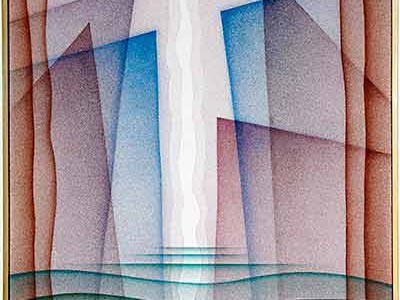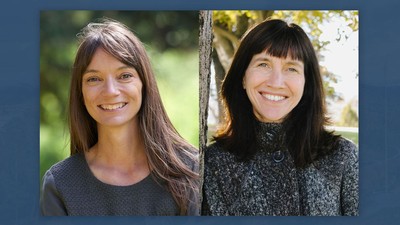Lauded Aboriginal Artwork on Display at Utah State University
Shorty Lungkarta Tjungurrayi (1920-1987), Mystery Sand Mosaic, November 1974. Synthetic polymer paint on canvas board. 25.875 x 24 inches. Collection of John and Barbara Wilkerson. © Estate of the artist licensed by Aboriginal Artists Agency Ltd.
Two complementary exhibitions featuring artists from the Australian Western Desert and the American West are opening in September at the Nora Eccles Harrison Museum of Art (NEHMA) at Utah State University.
“Abstraction and the Dreaming: Aboriginal Paintings from Australia’s Western Desert” (1971-present), featuring historic and contemporary works from private collections, is on view Sept. 12-Dec. 12, and “Transcendence: Abstraction and Symbolism in the American West,” drawn from NEHMA’s distinguished collection, from Sept. 1-May 7, 2016.
“Abstraction and the Dreaming” and “Transcendence” propose a reexamination of how we understand and experience art of the last century,” said Katie Lee Koven, NEHMA executive director and curator. “Both exhibitions help us understand artists and their work more individualistically, with layers of identity that are complex and distinctive yet, in some ways, connected.”
“Abstraction and the Dreaming” includes more than 50 artworks spanning the emergence of painting at Papunya, a remote Australian Indigenous settlement, to the present day. The early “Papunya boards” are descendants of mark-making that dates to well over 100 centuries ago and are the beginnings of the Western Desert art movement. With fewer than 600 in existence, the “Papunya boards” (1970s) have a singular status within the history of Australian Aboriginal art.
The first Papunya painters were men whose extensive cultural knowledge of ancestral stories, referred to as “dreamings,” provided the subject matter. Encouraged by a Sydney schoolteacher who provided materials — acrylic paint and masonite boards and, later, canvas — to create permanent works, the artists employed symbols used in other contexts. Among the male artists included are Long Jack Phillipus Tjakamarra, Tim Payungka Tjapangarti and Shorty Lungkarta Tjungurrayi.
Over time, Papunya artists moved away from the use of symbols toward greater abstraction. The scale of artworks on canvas grew and women began painting, using a markedly more gestural and vibrant style than their male counterparts. Today, these works are interpreted and experienced as contemporary abstract paintings, stimulating a rich dialogue about indigenous art in the contemporary art world. Among the women artists included are Makinta Napanangka, Ningura Naparrula and Naata Nungurrayi.
Works for the exhibition have been loaned from collectors John and Barbara Wilkerson, New York (John is an alumnus of Utah State University); Dennis Scholl, Miami; Julie Harvey, Idaho; and Stephen Luczo, San Francisco. Margo Smith, director and curator of Kluge Ruhe Aboriginal Art Collection at the University of Virginia, was hired to serve as guest curator for the exhibition.
Showcasing NEHMA’s important collection of 20th and 21st century art from the American West after World War I, “Transcendence: Abstraction and Symbolism in the American West” includes more than 60 works by 39 artists spanning painting, photography, sculpture, works on paper, pottery, video and mixed media.
The exhibition surveys American Indian and non-native artists — including Edward Corbett, Deborah Remington, Robert Irwin, Sibyelle Szaggars Redford, Henrietta Shore and Takako Yamaguchi — who employ abstraction and symbolism to convey their experiences and interpretations of the American West. Complementing “Abstraction and the Dreaming,” the exhibition explores how the artists utilize these conceptual processes to convey responses to place, spirituality and cultural identity.
Many works in the exhibition have been acquired by NEHMA through the generous support of the Marie Eccles Caine Foundation, Kathryn Caine Wanlass Foundation, Nora Eccles Harrison Treadwell Foundation and from David and Terry Peak.
The Nora Eccles Harrison Museum of Art is dedicated to collecting and exhibiting modern and contemporary visual art to promote dialogue about ideas fundamental to contemporary society. NEHMA provides meaningful engagement with art from the 20th and 21st centuries to support the educational mission of Utah State University, in Logan, Utah. NEHMA offers complementary public programs such as lectures, panels, tours, concerts and symposia to serve the university and regional community. Admission is free and open to the public. Hours are Tuesday-Saturday from 10 a.m. to 5 p.m. and by appointment. Visit the NEHMA website for more information.
Contacts: Katie Lee Koven, NEHMA executive director and chief curator, 435-797-0164, katie.lee.coven@usu.edu or
Maren Aller, USU Public Relations and Marketing, 435-797-1355, maren.aller@usu.edu
Raymond Jonson, Watercolor #10, 1938, airbrushed watercolor on paper, 21.75 x 20 inches. Marie Eccles Caine Foundation Gift, © University of New Mexico Art Museum, Albuquerque. Photo by Andrew McAllister, Utah State University.
TOPICS
Arts 238stories World 121stories Culture 75storiesComments and questions regarding this article may be directed to the contact person listed on this page.








